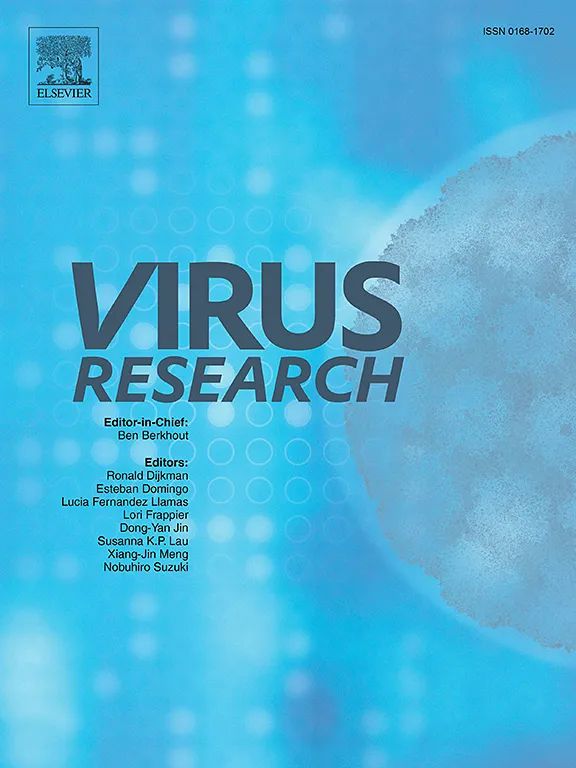Insight into noncanonical small noncoding RNAs in Influenza A virus infection
IF 2.7
4区 医学
Q3 VIROLOGY
引用次数: 0
Abstract
Influenza A virus (IAV) induces acute respiratory infections in birds and various mammals, including humans, and presents a significant global public health concern, with considerable economic consequences. Recently, researchers have shown keen interest in noncanonical small noncoding RNAs (sncRNAs) as carriers of epigenetic information, including tRNA-derived small RNAs (tsRNAs), rRNA-derived small RNA (rsRNAs), and Y RNA-derived small RNAs (ysRNAs). Particularly, tsRNAs and rsRNAs are detected in diverse species and demonstrate evolutionary conservation. We analyzed sncRNAs sequencing data in the pulmonary tissue of two genetically distinct mouse strains, C57BL/6J and DBA/2J, to explore strain-specific variations of sncRNAs in response to IAV infection. We systematically compiled information on noncanonical sncRNAs in these two strains and investigated the tsRNAs/rsRNAs/ysRNAs profiles influenced by IAV infection. Specifically, four noncanonical sncRNA families, including rsRNA-12S, GtsRNA-Arg-CCT, GtsRNA-Arg-TCT, and GtsRNA-Lys-TTT, exhibited upregulation upon IAV infection. Notably, DBA/2J mice showed earlier systemic differential expression of noncanonical sncRNAs after IAV infection compared to C57BL/6J mice. Additionally, our study revealed a strain-specific biogenesis of MtsRNAs in response to IAV infection. Also, distinct co-expression patterns of MtsRNAs were observed between C57BL/6J and DBA/2J mice, with DBA/2J mice showing broader positive co-expression of MtsRNAs with various sncRNA families compared to C57BL/6J mice. Our study provides a novel insight into noncanonical sncRNAs and their implications in IAV pathology and mouse strain specificity.
洞察甲型流感病毒感染中的非典型小非编码 RNA
甲型流感病毒(IAV)会诱发鸟类和包括人类在内的各种哺乳动物的急性呼吸道感染,是一个重大的全球公共卫生问题,并会带来相当大的经济后果。最近,研究人员对作为表观遗传信息载体的非经典小型非编码 RNA(sncRNA)表现出浓厚的兴趣,其中包括 tRNA 衍生的小型 RNA(tsRNA)、rRNA 衍生的小型 RNA(rsRNA)和 Y RNA 衍生的小型 RNA(ysRNA)。特别是,tsRNAs 和 rsRNAs 在不同物种中都能被检测到,并表现出进化保护性。我们分析了 C57BL/6J 和 DBA/2J 两种基因不同的小鼠品系肺组织中的 sncRNAs 测序数据,以探索 sncRNAs 在 IAV 感染下的品系特异性变异。我们系统地汇编了这两个品系的非规范sncRNAs信息,并研究了受IAV感染影响的tsRNAs/rsRNAs/ysRNAs谱系。具体来说,包括 rsRNA-12S、GtsRNA-Arg-CCT、GtsRNA-Arg-TCT 和 GtsRNA-Lys-TTT 在内的四个非典型 sncRNA 家族在 IAV 感染后表现出上调。值得注意的是,与 C57BL/6J 小鼠相比,DBA/2J 小鼠在感染 IAV 后更早出现非典型 sncRNA 的系统性差异表达。此外,我们的研究还揭示了 IAV 感染后 MtsRNAs 的生物发生具有株系特异性。与 C57BL/6J 小鼠相比,DBA/2J 小鼠的 MtsRNA 与各种 sncRNA 家族的共表达呈更广泛的阳性。我们的研究为非规范sncRNA及其在IAV病理学和小鼠品系特异性中的影响提供了一个新的视角。
本文章由计算机程序翻译,如有差异,请以英文原文为准。
求助全文
约1分钟内获得全文
求助全文
来源期刊

Virus research
医学-病毒学
CiteScore
9.50
自引率
2.00%
发文量
239
审稿时长
43 days
期刊介绍:
Virus Research provides a means of fast publication for original papers on fundamental research in virology. Contributions on new developments concerning virus structure, replication, pathogenesis and evolution are encouraged. These include reports describing virus morphology, the function and antigenic analysis of virus structural components, virus genome structure and expression, analysis on virus replication processes, virus evolution in connection with antiviral interventions, effects of viruses on their host cells, particularly on the immune system, and the pathogenesis of virus infections, including oncogene activation and transduction.
 求助内容:
求助内容: 应助结果提醒方式:
应助结果提醒方式:


